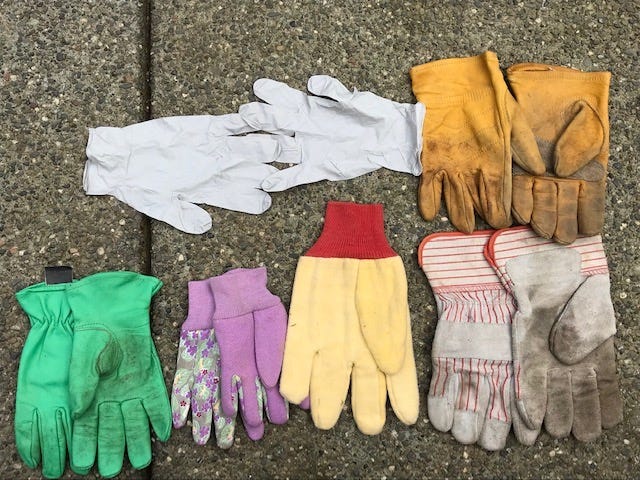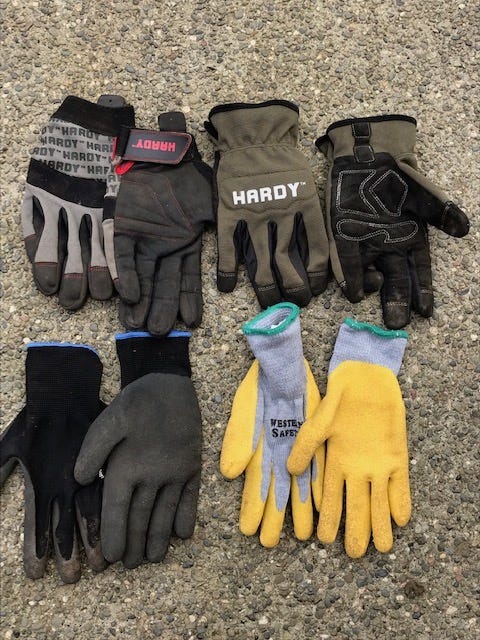Why Proper Gloves Are Essential for Gardeners
By Bob Niklewicz
NAPA VALLEY, Calif. — As an ergonomic consultant, I have worked with businesses whose employees perform a lot of tasks that require manual dexterity. Construction sites, wineries and high-tech clean rooms are good examples. Almost without exception, these workplaces present situations that require gloves. Gloves protect workers from abrasions, pathogens, and chemical and thermal hazards.
Gardening also falls into the category of jobs that require gloves. As gardeners, we put our hands into all kinds of places, from muddy soil to gravel to thorny bushes — not to mention the many vibrating power tools we use. And with our bare hands in soil, we can come into contact with sinister stuff that is not obvious to the eye.
Did you know, for example, that soil can contain Clostridium tetani (which causes tetanus infections), Clostridium botulinum (which causes botulism), anthrax, Staphylococcus aureus, Escherichia coli and Listeria? Granted, these pathogens aren’t commonly found in soil, but it happens, so why take a chance? Animal droppings and animal remains are the source of some of these contaminants.
These undesirables can enter the body via puncture wounds, abrasions, cuts, existing skin lesions, inhalation or digestion, so it is also important to keep your hands away from your nose and mouth when you are working in the garden.
Fortunately, there’s a glove for every situation. Rubberized or lined gloves will keep moisture away from your skin when you’re working in muddy areas. Leather gloves can protect you from abrasions when working in hard or dry soil. Latex or nitrate gloves are a good choice when you’re working with delicate plants as they protect you while preserving dexterity. Elbow-length leather or Kevlar gauntlets may be necessary when you’re working with thorny roses or woody shrubs. If you are handling a chainsaw, lawnmower or leaf blower, the vibration can damage nerves in your hands. Padded gloves absorb some of the vibration, lowering the risk of numbness or carpal tunnel symptoms.
I choose different types of gloves for different tasks, and I prefer not to spend a lot of money on them as I go through them so frequently. Following are some of the gloves I find most useful.
In the photo below (reading left to right starting with the top row), I use nitrate gloves for delicate work. I also use them as liners for the leather gloves on the right. The green leather gloves are for times when smaller hands are helping me, and the purple pair belongs to my granddaughter. The yellow gloves fit too loosely, but I still use those for warmth or tossing garbage. The red-striped ones are too bulky for most people. They protect hands from sharp edges, but they are unsuitable for fine motor tasks.
In the next photo are general-purpose gloves. The ones on the left side are flexible; the ones on the right have extra padding for use with vibrating tools. In the bottom row are rubberized gloves for working in wet areas, but be sure to add a nitrate liner for more protection.
In this photo are wrap-around leather sleeves that protect your forearms. Paired with wrist-high gloves, they approximate gauntlet-type gloves. In the bottom row, leather gauntlets work well for working in roses or clearing weeds. There is also a version made with Kevlar.
Make sure to choose the right gloves for the task and make sure they fit well. You can lose 20% to 40% of your grip strength by wearing bulky or poorly fitting gloves since it takes more strength to hold items when gloves do not fit. We go to great lengths to take care of our valuables, and our hands certainly rank high on the list of precious possessions that deserve constant protection.
Napa Valley Features’ Note
Here are few additional interesting facts about gardening gloves you might not know:
As mentioned, gardening gloves are essential not just for preventing cuts and scrapes but also for protecting against serious infections. In Northern California, issues such as poison oak and Valley fever (caused by Coccidioides fungus) can also pose health risks. Poison oak can cause severe skin irritation, while Valley fever, though not yet detected in Napa County, is becoming more prevalent in California, leading to symptoms such as fatigue, cough, fever and joint pain.
Gardening gloves come in a variety of materials, each suited to different tasks and environmental considerations. Bamboo fiber gloves are an environmentally friendly option that is soft, flexible and close-fitting. Leather and latex gloves are tear-resistant and provide excellent grip, making them ideal for heavy-duty tasks. Additionally, some gloves incorporate recycled materials, contributing to sustainability efforts.
Modern gardening gloves often include advanced features to enhance functionality and convenience. Some gloves are designed with touchscreen-compatible fingertips, allowing gardeners to use their smartphones without removing their gloves. Other features include reinforced palms and fingertips for durability, breathable fabrics to regulate hand temperature and elasticated cuffs to prevent soil and debris from entering the gloves.
Workshop: Join UC Master Gardeners of Napa County for “Succulent/Dry Garden: Double Your Pleasure — Double Your Fun” on Saturday, July 27, from 10 a.m. to noon, at Las Flores Learning Garden, 4300 Linda Vista Ave., Napa. Do you know the five most common ways succulents reproduce? Learn their secrets and how you can increase your plant collection or add to your low-water landscape through succulent plant propagation. Register here.
Library Talk: Join UC Master Gardeners of Napa County and Napa County Library for a talk on “Fabulous Ferns, Indoors and Out” on Thursday, Aug. 1, from 7 to 8 p.m. via Zoom. Ferns are an accommodating family of plants ranging in size from tiny to behemoth. Some species grow in air and others in water, as well as in just about any type of soil. Enjoy an overview of these remarkable plants and find the perfect one for your space. Register to receive the Zoom link.
Become a Master Gardener Volunteer: UC Master Gardeners of Napa County is now accepting applications for the Class of 2025. Visit napamg.ucanr.edu to read the informational brochure; then register to attend a mandatory information session for applicants. Application deadline is 5 p.m. on Sept. 25.
Help Desk: The Master Gardener Help Desk is available to answer your garden questions on Mondays and Fridays from 10 a.m. until 1 p.m. at the University of California Cooperative Extension Office, 1710 Soscol Ave., Suite 4, Napa. Or send your questions to mastergardeners@countyofnapa.org. Include your name, address, phone number and a brief description. For best results attach a photo.
If today's story captured your interest, explore these related articles:
Bob Niklewicz, PT DHSc, is a UC Master Gardener of Napa County.







Great article Bob! You have reminded me to use gloves even for the smallest task when I get too lazy to put on gloves!